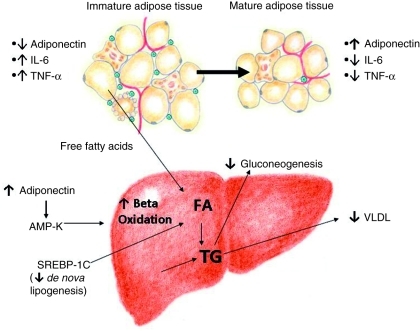Figure 1.
Adipose tissue and hepatic effects of the thiazolidinediones (TZDs). The TZDs have a complex and incompletely understood mechanism of action. In the setting of obesity and insulin resistance, visceral adipose tissue is characterized by an abundance of premature adipocytes and macrophages. This favors the production of several proinflammatory adipocytokines, including interleukin-6 and tumor necrosis factor-α (TNF-α) that promote cellular injury and further antagonize insulin action. Adiponectin is a protein hormone primarily secreted by mature adipose tissue that counteracts the effects of TNF-α and improves insulin sensitivity. Premature adipocytes within visceral adipose tissue produce very little adiponectin. TZDs promote maturation and redistribution of adipose tissue resulting in a reduction in macrophage infiltration and number of immature adipocytes. This diminishes the secretion of proinflammatory adipocytokines and increases adiponectin levels. Furthermore, direct effects on hepatic lipid metabolism increase beta oxidation, and decrease de novo lipogenesis, which then results in decreased very-low-density lipoprotein secretion and gluconeogenesis. AMP-K, 5′adenosine monophosphate-activated protein kinase; FA, fatty acid; SREBP-1c, sterol regulatory element binding protein-1c; TG, triglyceride; VLDL, very-low-density lipoprotein.

